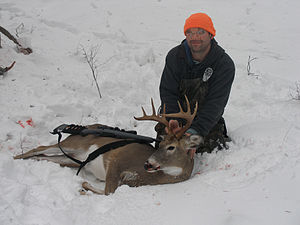 |
With
evidence of epizootic hemorrhagic disease (EHD) now affecting
white-tailed deer in more than 30 Michigan counties, Department of
Natural Resources Director Keith Creagh has signed an emergency order
that decreases antlerless license purchase limits for deer management
units (DMUs) where the most EHD-related die-offs have occurred. Director
Creagh signed the order during yesterday’s regular monthly meeting of
the Natural Resources Commission.
Effective
immediately, the purchase limit for DMU 486 (a multicounty unit in the
southern Lower Peninsula) is five private land antlerless deer hunting
licenses per hunter. Also effective immediately, the public antlerless
license purchase limit per hunter is two for each of the following DMUs:
012 (Branch), 034 (Ionia), 039 (Kalamazoo), 041 (Kent), 044 (Lapeer),
076 (Sanilac), 078 (Shiawassee), 079 (Tuscola) and 080 (Van Buren).
Individuals
who purchased antlerless licenses prior to this emergency order are not
required to return licenses. This order only applies to antlerless
licenses purchased on or after Nov. 8, 2012.
“With
this order, I hope to remind individuals to assess their local
situation, and in areas where EHD has hit the hardest, either take a
minimal number of antlerless deer or not take any at all,” said Director
Creagh. “We strongly believe most hunters will make the right call in
exercising restraint, but by working with the Natural Resources
Commission to enact this emergency order, we created a regulatory
mechanism to reinforce a more conservative approach.”
The
DNR apologizes for any inconvenience this may cause hunters, landowners
or license agents. However, this action was taken prior to the time
that license sales traditionally increase sharply just prior to the
opening of firearm season. The DNR feels the change was warranted in
order to acknowledge the heavy deer losses that have occurred in some
areas.
To
better address the public’s concerns and questions about EHD, deer
hunting, or deer in general, DNR’s wildlife veterinarian Steve Schmitt,
deer and elk program leader Brent Rudolph and Law Enforcement Division
Assistant Chief Dean Molnar will field questions in a cyber discussion
on Tuesday, Nov. 13, from 7 to 8 p.m. To join the live-streaming event,
residents are asked to visit www.facebook.com/midnr.
In
addition, on Wednesday, Nov. 14, from 10 a.m. to 3 p.m., DNR staff,
including Wildlife Division Chief Russ Mason and Assistant Chief Doug
Reeves, will be available for questions at some of the busiest retail
stores in southern Michigan. For a complete list of locations and
participating staff, visit www.michigan.gov/deer.
“This
is the perfect opportunity to connect with the hunting community on the
busiest license-buying day of the year,” said Mason. “We will be
stationed at more than 10 locations, and we hope hunters will stop by so
we can answer any questions they may have about EHD or other
deer-related concerns.”
EHD
is caused by a virus that is transmitted by a type of biting fly called
a midge. Deer can suffer extensive internal bleeding, leading to death
just a few weeks after infection with the virus. Due to a high fever,
infected deer often are found sick or dead along or in bodies of water.
Cold
weather reduces midge activity and frost kills the adults that bite and
transmit the virus, so most outbreaks have slowed if not stopped
completely.
EHD
does not affect humans, so edibility of the venison is not affected by
this disease. There is no evidence that humans can contract the EHD
virus either from the midge or from handling and eating venison.
The
DNR will take reports of dead deer that are likely EHD-related until
Jan. 1. To report the presence of dead deer, the DNR encourages
residents to contact their nearest DNR wildlife field office by
consulting the list available at www.michigan.gov/wildlife.


No comments:
Post a Comment